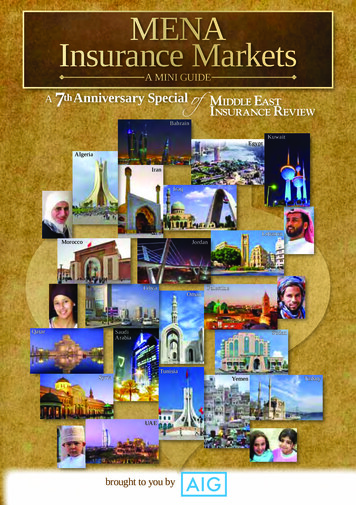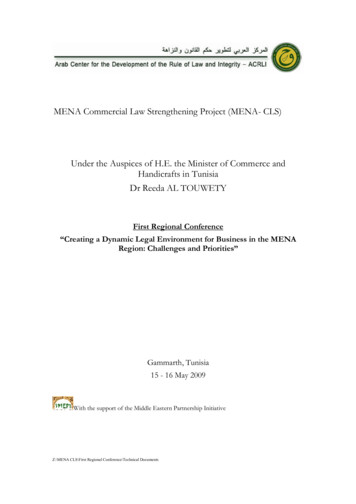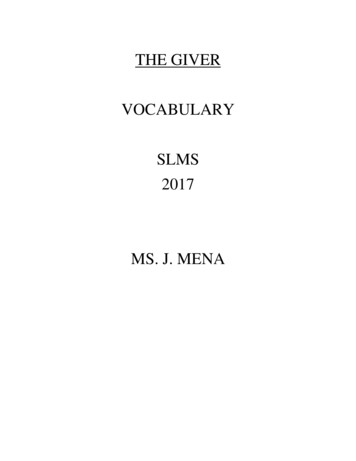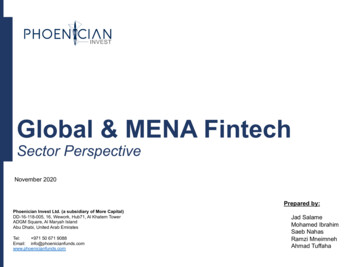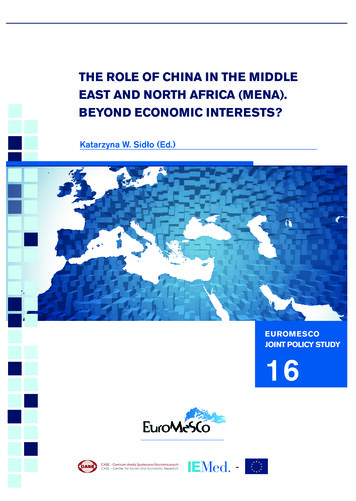
Transcription
INSURANCE UPDATEFEBRUARY 2021Middle East and North AfricaInsurance Market Report
INSURANCE UPDATEFEBRUARY 2021MENA InsuranceMarket ReportCONTENTS125IntroductionInsurance Coverage Rate TrendsCountry Analysis6 United Arab Emirates7 Saudi Arabia8 Bahrain9 Egypt10 Oman11 Qatar12 Conclusion
IntroductionAs with organisations globally, those in the Middle East and North Africa (MENA) regionare feeling the impact of transitioning insurance markets.COVID-19 has resulted in an economic slowdown, which hasadversely affected insurers and led to increased pricing andreduced capacity in many areas. This is affecting local markets –at a time when companies are focused on reducing costs.In MENA, local insurers are generally not able to act as a leaderon large insurance programmes, due to limited local capacity,and are more dependent on the reinsurance market. As a result,larger insurance programmes placed in MENA have beenaffected by changes to the international reinsurance market,which is transitioning and seeing widespread increased rates andreduced capacity.As a consequence, international reinsurers are taking less of ashare of many risks in the MENA region. Additionally, reinsurersare becoming more selective on the risks they do reinsure, andapplying more exclusions – for example, around pandemicrelated claims. Reinsurers have also imposed stricter measureson premium payment, in order to improve liquidity and controlbad debt reserves.Health insurance is less commonly reinsured in the internationalmarket, as major local insurers retain the risk, and does notrequire reinsurance support. In addition, COVID-19 has impactedthe performance of medical books positively, allowing insurersin MENA to still be more competitive, with some companies ableto achieve premium decreases, while others have seen premiumincreases – depending on their past claims performance.For property and casualty (P&C), competition remains highwithin the local markets, with appetite for smaller accountsactually increasing across MENA. However, with reinsurersimposing more limits on the risks they will accept, it’s harder tofind alternatives in the market. Similar to health insurance, motorinsurance witnessed positive performance and continued toshow competitiveness between local insurers.In the last 12 months, various laws and rules have beenintroduced across the MENA region to help advance its markets.Saudi Arabia – Several laws have been introduced aroundelectronic transactions, and mandatory leased motor policies.UAE – New anti-money laundering rules and reinforcement ofKYC rules are now in force.Oman – Will introduce its own medical plans.Bahrain – Will introduce its own mandatory medical plans.Kuwait – Has launched its own insurance laws.Egypt – The Financial Regulatory Authority (FRA) issuedDecrees No. 82, 85, and 91 (the “FRA Decrees”), whichsuspended the issuance of new licenses for insurance brokeragecompanies and amended the composition requirements ofreview committees in listed companies.NOTE:With the global and regional insurance markets in transition, it is more important than ever for insurance buyers to work with theirbrokers and other counsel to prepare diligently and well ahead of insurance renewals.Marsh 1
Insurance Coverage Rate TrendsConstructionIncreaseInsurance prices in the construction market had been decliningsince around 2005. However, this trend started to reversemid-2018, due to some large global losses, including one thatmay become the largest-ever loss – estimated to be over US 2billion.Other factors affecting the MENA construction insurance marketinclude: Major energy construction and operational losses in theMiddle East, which have far exceeded insurance marketestimates. Some poorly performing syndicates exiting the constructionsector, following a Lloyd’s of London performance review. Increased natural catastrophe events, particularly flooding, invarious regions. Increased market consolidation/restructuring of majormarkets; for example, over the past year, three major insurersclosed their construction desks in the Dubai InternationalFinancial Centre (DIFC).Another issue faced by insurance buyers is the validity periodof quotations. Where it would once have been possible toextend the validity of a quote over a few months, it has nowbeen reduced to a few weeks after which insurers revise theirquotations.CyberIncreaseAt the start of 2020 cyber insurance rates remained stable, witheven some reductions seen. In the last three months, however,insurers have pushed for rate increases due to a rise in globalransomware claims and the expectation that we will see a similarfrequency of insured losses in MENA.Any price increase will very much happen on a case-by-casebasis. However, prices may increase more into 2021, and someinsurers have already, unsuccessfully, pushed for greater rateincreases across the board.Coverage is fairly stable, as is capacity, although some insurershave tried to reduce capacity. However, the MENA cyberinsurance market still sees more entrants, with increasingcapacity available in the Middle East, which helps to maintain acertain level of competition between insurers and ensure bestterms and conditions. The reinsurer market downgrading or, in some cases, goinginto runoff. Significantly reduced capacity among global reinsurers.Prices and deductibles continued to increase through 2020,pushing up the cost of insurance compared to similar projectsplaced in 2019. Some key reinsurers have exited the businessdue to revised risk appetites, while remaining reinsurers havetaken a tougher stance on terms and conditions. This has led tofewer markets being willing to offer lead quotations, with moreinstead opting to provide follow-on support – and only if theterms and conditions are aligned with their guidelines.2 Middle East and North Africa Insurance Market Report 2021Directors and OfficersIncreaseDirectors and officers liability insurance rates continue toincrease considerably. Capacity is still contracting significantly,while insurers continue to be concerned about COVID-19’simpact, particularly on liquidity and future insolvencies. Thishas led to insurers pushing to restrict coverage, particularlyaround insolvencies.
Rates have increased, on average, considerably year-over-year.In particular, the aviation, hospitality, and retail sectors haveseen large rate increases. There have been no recent new claimsnotifications, but insolvency-related claims are expected in thenext few months.However, local underwriters are still keen on long-termrelationships, and do not want to lose clients. Consequently, rateincreases can sometimes be negotiated, which is much less likelywith London underwriters.Six Lloyd’s of London underwriters used to write marineinsurance through the Lloyd’s DIFC platform, but now only two orthree Lloyd’s underwriters remain.EnergyIncreaseThe energy market in the region continues to be a strong accesspoint for capacity, despite the withdrawal from the DIFC of someinternational insurers during 2020.The last two years have seen the return of strong underwritingdiscipline for downstream risks with, in 2020, a second year ofstrong rate increases together with pressure on deductibles andrestrictions in coverage and conditions.The focus on quality risk engineering information is a continuedfeature of the downstream energy market.For risks in the upstream sector, after an essentially flat 2019,prices modestly rose throughout 2020, but at a very differentpace than the downstream sector.While some stabilisation is expected in the downstream marketin 2021, or at least a much lower rate of increases, the upstreamsegment may continue to see increased rates and reducedcapacity in the coming year.However, the sub-sector of the energy market – third-partyliabilities – is showing the strongest signs of volatility, with mostinsurers reviewing and restricting coverage and imposingsubstantial price rises, particularly for companies in the regionpurchasing significant limits.The marine market has recently seen some notable claims.For example, on the cargo side, a car carrier capsized off theUS coast, with all the risk underwritten in the MENA GulfCorporation Council (GCC). Meanwhile, a loss of a livestockcarrier – which sank in a typhoon off the coast of Taiwan – causeda local market loss of around US 25 million. Additionally, a fire ina Qatar shipyard, causing the destruction of a royal family yacht,led to a loss of more than a US 100 million.PowerIncreaseThe insurance market for power and utilities continued to tightenthroughout 2020, with double-digit rate rises. Steady rises,coupled with a review of deductibles, have become the norm,without a changing trajectory expected in 2021.Although renewables was the most competitive segment of thepower sector over the last few years, we have witnessed a lack ofappetite for solar and wind, forcing MENA-based risks to rely oninternational capacity to complete placements.Professional LiabilityIncreaseRates are increasing in the professional liability (PL) insurancemarket, while capacity is decreasing.MarineIncreaseMarine insurance in MENA has recently become subject to farmore scrutiny and rigour. Local underwriters are moredisciplined than just a year ago, while their claims settlementteams are scrutinising claims far more. There is now lessdifference between London market underwriters andlocal underwriters.In line with increasing rates overseas, local market rates areincreasing. For fleets with a bad claims history, rate increasescan be considerable.Capacity for project-related PL insurance has decreased hugely.Meanwhile, PL insurance for small and medium-size projects hasbecome far more commonplace, with lower insurance limits andextremely variable annual pricing. Conversely, very-large projectshave become less commonplace, although capacity for suchprojects is much reduced, while rates are increasinglysignificantly.Policy wordings remain fairly stable, but continue to be slightlynarrower than those in London. Rates are generally a bit higher inthe North Africa market than in the Middle East, with the Frenchinsurance market used more than before.Marsh 3
PropertyIncreaseThe MENA region currently has a two-tier property insurancemarket: tier-one comprising local insurers and tier-twocomprising international (re)insurers. Companies requiringlarge reinsurance capacity – for example risks with valueaccumulations of greater than US 500 million – are generallyseeing rate increases, as large insurers seek higher rates,increased deductibles, and deploy less capacity. However,companies with capacity requirements that can be satisfied bylocal markets are generally seeing flat rates and, in some cases,reductions.More generally, companies with poor loss experience, or highasset values or high-risk exposures – where pricing is driven bythe reinsurance market – are seeing significant rate increases.Meanwhile, every risk now requires a compelling argument toconvince underwriters to offer the most competitive terms.Companies should be prepared to provide more underwritinginformation, including survey, construction, occupancy,protection, and exposure information.In addition to pricing, coverage (particularly for contingentbusiness interruption, non-damage business interruption,disease, and cyber), deductibles, and business interruptionwaiting periods are being scrutinised as insurers seek certaintyof coverage exposure and reduce their attritional loss exposure.More insurers are also attempting to apply natural catastrophesub-limits.Additionally, COVID-19 remains a question mark over manyrenewals and coverage issues, with legal actions elsewherelikely to influence successful claims settlements.4 Middle East and North Africa Insurance Market Report 2021Trade CreditIncreaseThe last year was one of the toughest years for the trade creditmarket. It is estimated that trade credit insurers could faceclaims/loss ratios in excess of 100% in 2020 and 2021. This isalready causing the market to transition further, as insurersand reinsurers anticipate increased losses. Additionally, in 2021credit specialties insurers are likely to experience top-downpressure from a more systemic transitioning in the (re)insurancemarket.Credit insurers have taken a very conservative position on somesectors, in particular retail, travel/hospitality, aviation,automobiles, home appliances, commodities, and construction.Insurers’ approach to large exposures has also changedconsiderably, with more focus on risk-sharing measures andother loss mitigants to manage the underlying risk.Foreign investors and overseas lenders are likely to faceheightened credit risk, political risk, and performance challengesresulting from the wider global economic pressures. Thiswill drive demand for credit insurance solutions from bothcorporates and banks/financial institutions. As we emerge fromthe economic crisis, priorities will switch to expanding sales andsecuring funding for strategic development, and credit insurancewill play a critical role in ensuring certainty of receivables andproviding access to better liquidity.
Country AnalysesInsurance Rate Changes By CountryUAESaudi rkers’CompensationPropertyMedicalQ1 & Q2Q3 & Q4LifeR ATE TRENDSIncreasedStableDecreasedMarsh 5
UAEGeneral LiabilityGeneral liability rates continue to fall for smaller accounts, dueto high competition, and capacity remains stable among localinsurers. However, for larger programmes requiringreinsurance, rates are increasing and capacity is reducing.MotorRates are reducing, due to continued competition amonginsurers, who find the business line attractive for cash flowpurposes. Regulation – such as the introduction of tariff rates –has increased performance, resulting in insurers offering morecompetitive terms. This trend has been compounded by socialrestrictions relating to the COVID-19 pandemic, which hasresulted in less driving and, consequently, fewer accidents.Many insurers are fighting to retain business in this market,while many companies are pushing for price reductions dueto lockdowns. Since lockdown, most companies – from SMEsthrough to large international companies – have requestedremarketing their programme to try and achieve a ratereduction. However, in many cases a rate reduction is onlypossible by sacrificing some benefits from the programme, yetthe improvement of claims performance has helped to achieveexpiring terms.LifeLife insurance continues to be extremely competitive, withincreased capacity and possible large rate reductions available tosome companies. Some insurers have widened their terms andconditions, and reduced the number of exclusions in their policywordings. Many are offering discounts when medical and lifeinsurance programmes are combined.Workers’ CompensationThe workers’ compensation market has seen little change in2020, with the market still competitive and limits remainingfairly low. Rates are still going down, but not steeply, becausemargins are minimal. Some companies now have smallerworkforces, due to cutbacks caused by the COVID-19 pandemic,and therefore small overall exposures – and consequently lowertotal premium spend.PropertyRates are increasing due to reduced capacity, resulting from(re)insurers changing jurisdiction (for example, moving back toheadquarters), resetting underwriters guidelines, and applyinginternational standards. Additionally, in light of the pandemic,insurers are looking to introduce restrictions on pandemicrelated coverage (for example, non-material damage BI-relatedclaims).MedicalThe market’s overall claims performance improved because oflockdowns, but government intervention – where it mandatedthat all insurers had to pick up COVID-19 expenses in EmirateDubai – impacted affected insurers’ reserves, which are likely todeteriorate in an anticipation of further pandemic waves.OpportunitiesSince lockdown, there has been a huge increase inonline portals – for example, medical advice becamemore available online. All insurers now have portals tomanage day-to-day policies.In order to pursue further growth opportunities,insurers will explore niche lines of business that havebeen less affected by the pandemic – for example,logistics and manufacturing. Other areas of interestinclude employer protection, cyber, and trade credit.R ATE TRENDSIncreased6 Middle East and North Africa Insurance Market Report 2021StableDecreased
Saudi ArabiaGeneral LiabilityLifePricing increased slightly in 2020, driven largely by changes tothe international reinsurance market, which the local marketdepends on heavily due to its own small capacity.Life insurance prices increased slightly, on average, in 2020.Some policies may increase more substantially, however, whererequests are made to remove pandemic exclusions. Most grouplife policies cover deaths relating to COVID-19, although somepolicies exclude it.MotorMotor insurance’s share of the overall insurance industry hasdeclined from 34% to 25% in Saudi Arabia. Pricing has declinedslightly, driven by competition among insurers, who areattracted to the line of business because of its relative simplicityand the cashflow it provides them. Additionally, claims haverecently decreased due to COVID-19-related lockdowns andsocial restrictions.Workers’ CompensationDue to well-established compulsory workers’ compensationinsurance, most claims are addressed by the GeneralOrganisation for Social Insurance (GOSI). This insurance isusually opted for to cover employers’ liability and, since theenvironment is not particularly litigious, there are few claims,making this insurance very attractive to insurers.PropertyPrices have increased slightly in 2020 – driven by thetransitioning international reinsurance market, which is seeingincreased prices and reduced capacity. Local capacity remainsstable, however. There has been widespread withdrawal ofpandemic-related coverage, although 2020 saw relativelyfew claims.MedicalThe medical insurance market was stable in 2020, with noincrease in rates, on average. However, 2021 will likely see asmall increase due to standard inflation. The government iscurrently carrying the cost of COVID-19-related treatment, butinsurers will carry the costs from 2021. Claims decreased duringthe lockdown but jumped in June, due to deferred treatments.R ATE TRENDSIncreasedStableMarket UpdatesThere is a trend towards insurance marketconsolidation, with some insurers merging followinga clear directive from regulators, who want to ensurelocal insurers are financially strong. This trend is likelyto continue in 2021-22.DecreasedMarsh 7
BahrainGeneral LiabilityMedicalAlthough general liability insurance is not mandatory inBahrain, major companies and government projects insisttheir contractors buy it, along with professional indemnity –particularly for construction projects.MotorMotor insurance rates rose in 2020, due to the introduction ofa minimum deductible. This increase occurred despite motorclaims declining since the COVID-19 pandemic.Mandatory medical insurance is set to be introduced in Bahrain,although the rollout date is uncertain and has likely been pushedback by COVID-19. More generally, medical insurance is beingrecalibrated, with year-over-year rate increases on average,depending on loss record. Use of telemedicine has increasedconsiderably since the start of the pandemic, allowing insurers tobetter control claims. With medical insurance now needing to bepaperless, lots of insurers are investing in technology and, insome cases, passing on some of the cost of this technology in theform of increased premiums.LifeWorkers’ CompensationWorkers’ compensation insurance is provided by the GeneralOrganisation of Social Insurance (GOSI), designed by theBahraini Government with limited cover. In addition to theexisting GOSI cover, local insurers tend to provide difference inconditions/difference in limit (DIC/DIL) of GOSI benefits in orderto fill the gap in the cover. Most workers’ compensation policiesare issued with the extension of employers’ liability. Workers’compensation and employers’ liability policies are generallyrequested by multinational companies or as part of contractualrequirements.Life insurance rates increased slightly – triggered by earlyconcerns about COVID-19. Local insurers have had to step upand cover COVID-19-related deaths. As a result, their treaty costshave increased, so they are passing the costs back topolicyholders. This trend will stabilise in 2021 – despite increaseddemand for life insurance, with rates likely to peak and possiblyslide a little – because of more premium in the market.More generally, analysts predict that Bahrain’s insurance market– currently the smallest in the Gulf Cooperation Council – havegrown by about 7% each year until 2021. Following theeconomic impact of COVID-19, large-scale investment in civicprojects such as roads, schools, and housing is likely in 2021.Rates have increased on average – due to insurer nervousnessaround COVID-19 and remote working. This is despiteCOVID-19-related social restrictions leading to a reductionin claims. However, the premium rates are still comparativelycheap, compared to some other MENA regions, due to primaryGOSI cover.PropertyThe property insurance market continues to have plenty ofcapacity, although this is heavily dependent on the internationalreinsurance market. Insurers are increasingly nervous aboutaccumulation of risk relating to megamalls, for which premiumshave increased considerably. Insurers are also increasinglyconcerned about older buildings (20–25-years-plus), regardlessof occupation. Such buildings are still insurable, but have alsoseen a considerable rating increase, on average.R ATE TRENDSIncreasedStableDecreased8 Middle East and North Africa Insurance Market Report 2021Other NewsA Personal Data Protection Law has been written intocivil law. The Central Bank of Bahrain is mandating thatall financial institutions provide evidence cover as part oftheir statutory annual returns, which allows them to gettheir license. Thus, for any Central Bank of Bahrain(CBB) licensees, cyber insurance is also now mandatory,due to these new data protection regulations.
EgyptGeneral LiabilityRates are still declining for construction business that doesn’trequire reinsurance support and is placed locally. Rates areincreasing, however, for large projects whose insuranceprogrammes require reinsurance support. For operationalbusiness, rates are still increasing, because most general liabilityin the operational phase is covered by the international market,which has been in transition.MotorMotor rates are generally increasing, although the extentdepends on companies’ individual loss records. Rates areincreasing for companies with a loss record, but are sometimesstable for companies without any losses.The number of motor accidents and claims have recentlydecreased because of fewer cars on the road. However, repairshops have increased the cost of spare parts, so the average costof each claim has increased. Local market capacity is large, sothere is no need for reinsurance capacity.PropertyThe property market has seen some rate increases. Currently,most international reinsurance capacity has decreased –impacting rates badly. In March, heavy rain resulted in largelosses for some companies. As a result, insurers are nowmore concerned about taking a large retention, and tendto reinsure a large part of the risk.MedicalCOVID-19 has increased many companies’ demand for medicalcoverage. At the same time, however, rates are increasingconsiderably, due to the large number of COVID-19-relatedclaims.LifeLife insurance is stable in Egypt, despite a large number of fatalclaims due to COVID-19. Meanwhile, coverage and capacityremain unchanged from 2019.More generally, the potential for growth within Egypt’s insurancesector appears strong. Low insurance penetration rates andopportunities, such as the introduction of micro-insurance,could boost the sector. Micro-insurance has startedto be offered by some markets – for example, for smallercompanies. Construction is also seen as a major line of businessin the market, due to the potential investment in construction/infrastructure projects – including roads, bridges, and the metro.R ATE TRENDSIncreasedStableDecreasedMarsh 9
OmanGeneral LiabilityThe general liability market has been largely stable during 2020,with perhaps a slight increase in rates due to reduced capacity.Rates depend greatly on each individual company’s risk profile,with the hotel and tourism industry most affected, since they aremore prone to pandemic claims. However, all liability policiescurrently exclude COVID-19.MotorThe motor industry is one of the largest segments of Oman’sinsurance industry. It has seen recent reductions in pricing, dueto strong competition among insurers. Markets have devisedonline solutions to help people buy motor policies more easily (inlight of pandemic-related social restrictions), which has resultedin more policies being issued.Workers’ CompensationWorkers’ compensation insurance is mandated by law in Oman.Increasingly, it is becoming a contractual requirementin local and trading contracts, as the trading communitybecomes more risk-aware. Some companies combine theirworkers’ compensation insurance with their group life policy toreduce costs.Property and EngineeringThe property and engineering insurance market has undergonesignificant turbulence since 2018 – when the Dhofar regionswere heavily hit by multiple catastrophic cyclones. Prior to that,the property market was stable, due to the Middle East regionhaving not experienced many catastrophic losses, and the(re)insurance markets’ leniency in accepting risks in the regionwithout any limitation.However, in 2018 Cyclone Mekunu caused heavy losses – withone of Oman's ports recording a significantly high claim as aresult – which affected the entire Middle East (re)insurancemarket. Following this and various other subsequent cyclonesin Oman, the reinsurance market started to correct rates anddeductibles. Many (re)insurers have left the property market,resulting in it being downgraded due to financial instability andreduced capacity.10 Middle East and North Africa Insurance Market Report 2021Three or four regional markets have withdrawn fromunderwriting coastal properties; all these markets had injectedhuge capacity in accepting Omani risks, which has clearlycreated a considerable hole in their capacity.Post COVID-19, the market is likely to deteriorate furtheras insurers experience potential business interruptionclaims associated with COVID-19. This is despite COVID-19exclusions being strictly applied to all renewal and new policies.Grid-station, infrastructure, and electrification project rates havetripled in the last six months, due to claims and a lack of capacityin the market. This has rendered local insurers heavily dependenton the international reinsurance market, leading to increasedpremiums and larger deductibles.MedicalQ1 & Q2Q3 & Q4Insurers were analysing COVID-19’s impact in the first two quarters.Regulators mandated that all medical expenses for COVID-19positive cases (excluding those relating to self-quarantine) had to becovered by medical insurers in Oman, irrespective of theirreinsurance support, effective from 31 May.Since most medical policies exclude pandemic costs, thecosts relating to COVID-19 have ended up in net and treaty,which is expected to affect the available capacity later on andincrease the loss ratio.However, while the pandemic has run across nearly a year now in thesultanate, medical insurance portfolios have seen a considerabledrop in utilisation, resulting in a healthy loss ratio across medicalinsurers. Unlike in the past, where the medical portfolios have alwaysseen an increase in renewal rates owing to unfavourable loss ratios,medical inflation in the third quarter of 2020 and first quarter of 2021renewals have seen reduced pricing from expiring, even foraccounts that had abnormal loss ratios in previous years. Thoughthis is owing to the pandemic and related social restrictions, thenumber of people visiting hospitals for other medical conditions andtreatments have been delayed. Once COVID-19 abates, the numberof medical claims will likely increase and the claims utilisation trendswill return to normal – affecting pricing in the next renewal.Other NewsVAT is not currently applicable in Oman, but it isexpected to apply to all insurance policies byApril 1, 2021.
QatarGeneral LiabilityAfter declining rates for the last five years, rates are nowincreasing despite no major claims recently being reported.The rates for general liability (GL) have been increasing in thepast two years more specifically on placements, which rely onthe reinsurance markets for terms/support. In those cases, theincrease in premium is a reflection of the hardened reinsurancemarket conditions. Policies that are quoted by the insurerslocally, haven't seen a similar increase vis-à-vis thosesupported by the reinsurance markets.MedicalMost employers are keen to renew/place their medical coveragewith local insurers, or insurers who can offer local networkservices. International insurers are also playing a key role byoffering wider coverage benefits and better services. Medicalinflation is projected to remain stable and similar to past years.Medical insurance policy rates have seen revisions as they arelinked to their loss ratios, with many programmes experiencingloss ratios of more than 100%, consistently.Group LifeMotorInsurers expect an average annual increase, though rates arelikely to become more stable in the next 12 months. Inflationaryclaims trends will continue to be a challenge for motor insurers,but are expected to ease off gradually in the next 12 monthswith the successful resolution of the diplomatic boycott andblockade, which had led to increased costs for spare parts dueto supply diffi cu
with London underwriters. Six Lloyd's of London underwriters used to write marine insurance through the Lloyd's DIFC platform, but now only two or three Lloyd's underwriters remain. The marine market has recently seen some notable claims. For example, on the cargo side, a car carrier capsized off the

